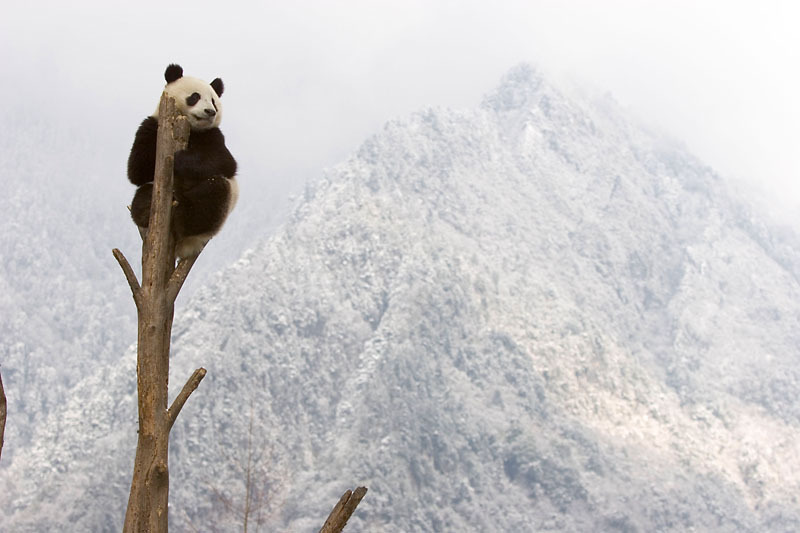The WWF is run at a local level by the following offices...
- WWF Global
- Adria
- Argentina
- Armenia
- AsiaPacific
- Australia
- Austria
- Azerbaijan
- Belgium
- Bhutan
- Bolivia
- Borneo
- Brazil
- Bulgaria
- Cambodia
- Cameroon
- Canada
- Caucasus
- Central African Republic
- Central America
- Chile
- China
- Colombia
- Croatia
- Democratic Republic of the Congo
- Denmark
- Ecuador
- European Policy Office
- Finland
Giant pandas
Pandas: an emblem of global biodiversity
After decades of effort, wild panda numbers are rising, but there are still only 1,864 spread across 20 pockets of bamboo forest. And the remaining pandas still face a number of threats, particularly habitat loss and fragmentation.
But the Chinese government is committed to conserving the species and its habitat, and has already drastically increased the number of panda reserves.
Our 10 year strategy focuses on improving panda habitat in a manner that balances conservation with local sustainable development.
- Marco Lambertini, WWF Director General.
Why are we helping the giant panda?
Pandas play a crucial role in China's bamboo forests by spreading seeds and helping the vegetation to grow. And it's not only these unique forests that benefit. We're also providing a lifeline for a host of other endangered animals, including the golden snub-nosed monkey, takin and crested ibis that share these magnificent forests with the panda.
The panda’s habitat is also important for the livelihoods of local communities, who use it for food, income, fuel for cooking and heating, and medicine. And for people across the country.
Sir Peter Scott - one of our founders - drew the first logo in 1961, describing the need for "an animal that is beautiful, endangered, and loved by many people in the world."
The panda has since become a symbol not just for WWF but also for the conservation movement as a whole.
 Giant panda numbers are slowly increasing, but the rare bear is not out of the woods yet.
Giant panda numbers are slowly increasing, but the rare bear is not out of the woods yet.
Traditional threats to pandas such as poaching appear to be declining, but large-scale disturbances including
- Mining
- Hydro-power
- Habitat loss
- Hunting
- Tourism
While its numbers are slowly increasing, the giant panda remains one of the rarest and most endangered bears in the world. Creating new reserves and linking up existing panda populations are key to the species' future.
 After a significant increase in recent years, China now boasts a network of 67 panda reserves, which safeguard almost two-thirds of the giant pandas in the wild and just over half of their existing habitat.
After a significant increase in recent years, China now boasts a network of 67 panda reserves, which safeguard almost two-thirds of the giant pandas in the wild and just over half of their existing habitat.
But habitat loss and fragmentation remain the gravest threats to the survival of the species.
A large proportion of the panda's habitat has already been lost: logged for timber and fuel wood, or cleared for agriculture and infrastructure to meet the needs of the area's booming population.
The Chinese government banned logging in the panda's habitat in 1998, but new roads and railways are continuing to cut through the region, further fragmenting the forests. This isolates panda populations and prevents them from breeding.
It also leaves them more vulnerable to bamboo die-offs. Bamboo naturally dies off every 40-120 years, depending on the type. In the past, pandas could migrate to new areas in search of food, but nowadays that they are no longer able to ‘follow’ the bamboo.
 The panda's mountainous forests continue to be degraded by people harvesting bamboo, gathering firewood and collecting medicinal herbs.
The panda's mountainous forests continue to be degraded by people harvesting bamboo, gathering firewood and collecting medicinal herbs.
The Minshan Mountains alone contain over 5,000 plant species: 75% of which are used in traditional Chinese medicine. Harvesting these medicinal plants provides many families with an important source of income. But it also places additional pressure on the fragile forests.
As does mass tourism. The construction of tourist facilities and the rapidly increasing number of tourists in the forests is causing significant disturbance to pandas and their habitats.
Some poaching of pandas still occurs. Hunting the animals for their fur has declined due to strict laws and greater public awareness of the panda’s protected status.
While it is rare for poachers to intentionally kill a panda, some are accidentally injured or killed by traps and snares set for other animals, such as musk deer and black bears.
Pandas eat for around 14 hours a day, consuming up to 38kg of bamboo

We have a ten year plan for giant panda conservation.
Looking ahead
The strategy - which started in 2015 - focuses on improving panda habitat in a manner that balances conservation with local sustainable development. We're working with the government, partners, and the public to protect key habitats and ensure a sustainable wild giant panda population; whilst also benefiting local communities.

We're protecting areas and bamboo corridors
Creating new reserves and linking up existing panda populations are key to the species' future. While the number of panda reserves has increased to 67 in recent years, but this still leaves around 1/3rd of wild pandas outside protected areas.
We've partnered with the Chinese government, to develop bamboo corridors to link pockets of forest, allowing the pandas within them to move to new areas, find more food and meet more potential breeding mates. But with panda habitat continuing to be fragmented by roads, railways and other human development, additional corridors will be needed to connect isolated panda populations.

We're promoting conservation and community development
But simply providing more land for pandas is not enough. Only by effectively addressing the needs of local people and sustainably enhancing their livelihoods can we hope to guarantee the long term survival of the giant panda.
We're working with Chinese authorities to initiate a variety of community development projects in the Minshan and Qinling Mountains, that provide local communities with alternative, sustainable livelihoods, find a wider market for locally produced goods, and alternative energy sources. We're also showing communities how to protect panda habitat without compromising their economic livelihoods.
These conservation efforts don't just benefit giant pandas. Our work also benefits many other rare species of animals and plants that live side-by-side with the pandas, including the endangered takin, golden monkey, red panda, and crested ibis.
You can help keep panda numbers growing
Panda numbers have increased in the last ten years but your help is needed to protect their natural habitat, stop poachers and ensure future population growth.
Your donation will contribute towards a variety of initiatives, including:
- Nature reserve protection
- Community development projects
- Research and monitoring work




